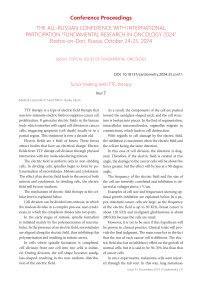Tumor treating field (TTF) therapy
Бесплатный доступ
TTF therapy is a type of electric field therapy that uses low-intensity electric fields to suppress cancer cell proliferation. It generates electric fields in the human body which interfere with rapid cell division in cancer cells, triggering apoptosis (cell death) locally or in a partial region. This treatment is over a decade old.
Tumor treating field, ttf, therapy
Короткий адрес: https://sciup.org/148329767
IDR: 148329767 | DOI: 10.18137/cardiometry.2024.33.conf.1
Текст статьи Tumor treating field (TTF) therapy
Tumor treating field (TTF) therapy
Inui T.
Medical Corporation “Saisei Mirai”, Osaka, Japan
TTF therapy is a type of electric field therapy that uses low-intensity electric fields to suppress cancer cell proliferation. It generates electric fields in the human body which interfere with rapid cell division in cancer cells, triggering apoptosis (cell death) locally or in a partial region. This treatment is over a decade old.
Electric fields are a field of forces. These forces attract bodies that have an electrical charge. Electric fields from TTF disrupt cell division through physical interaction with key molecules during mitosis.
The electric field is uniform only in non-dividing cells. In dividing cells, spindles begin to form by polymerization of microtubules. Mitosis and cytokinesis. The effect of an electric field leads to the arrest of both mitosis and cytokinesis. In dividing cells, the electric field will be non-uniform.
The mechanism of electric field therapy at the cellular level is explained below.
Cell division can be divided into mitosis, in which the nucleus divides in a complex process, and cytokinesis, in which the cytoplasm divides into two parts.
In the early stages of mitosis, spindle formation is initiated mainly by the polymerization of microtubules. In the presence of an electric field, microtubules are aligned along the electric field, thus inhibiting this polymerization and resulting in mitotic arrest.
In cells where spindle formation is completed, cell division from one cell into two cells is initiated. During division, the cell shape becomes sandglass-shaped, resulting in the non-uniform distribution of the electric field.
As a result, the components of the cell are pushed toward the sandglass-shaped neck, and the cell structure is broken into pieces. In the End of segmentation, intracellular macromolecules, organelles migrate to constrictions, which leads to cell destruction.
With regards to cell damage by the electric field, the inhibition is maximum when the electric field and the cell are facing the same direction.
In this case of cell division, the direction is diagonal. Therefore, if the electric field is created at this angle, the damage to the cancer cells will be about five times greater, but the effect will be less at a 90-degree angle.
The frequency of the electric field and the size of the cell are inversely correlated and inhibition is observed at voltages above 1 V/cm.
Examples of cell size and frequencies showing optimal growth inhibition are explained below. In a paper, intestinal cancer cells are large, so the frequency of the electric field is up to 50 KHz, breast cancer is about 120 KHz and malignant glioblastoma is about 200 KHz because the cells are small.
However, it is yet to be seen if this hypothesis will be proven in clinical practice. Clinical trials will provide the final judgment. The main issue lies in the fact that the size of each cancer cell is different. The electric field also has an inhibitory effect on the growth of normal cells, but it is said to be 50-70% less than that of cancer cells.
In mice experiments, melanoma cells were injected through the tail vein. In this way, lung metastasis
Issue 33. November 2024 | Cardiometry | 11
occurred, but the electric field therapy group showed more inhibition of metastasis than the control group.
Similarly, in rabbits with renal cancer as the primary tumor, the electric field therapy group showed inhibition of lung metastasis.
When electric field therapy is used daily for more than 12 hours, it will cause necrosis of the tumor in a couple of months.
Saisei has been developing and producing Tumor Treating Field blankets to target cancer cells while you are sleeping. This is because the blood flow in your body is constant while you are sleeping, because you don’t eat and you don’t exercise, which cannot affect the formation of the electric fields. This therapy is very convenient for many patients, as they need to work during the day time. Indications for electric field therapy are below.
TTF therapy has been used clinically for malignant glioblastoma, lung cancer, breast cancer and for almost all solid cancers in the body.
We usually combine TTF therapy with GcMAF or Dietary MAF. Because macrophages activated by Gc-
MAF or Dietary MAF can phagocytize not only dead cancer cells but also damaged cancer cells. At the same time, antigen- presenting cells activated by MAF work together with T lymphocytes and B lymphocytes to attack cancer cells, which has maximum effects for patients. Tissue-resident macrophages are distributed throughout the body and can perform a wide variety of functions, including tissue regeneration.
Lastly, if summarizing Saisei TTF therapy it includes the following:
– Direct current (DC pulse), we are currently developing a new electric field therapy.
– No need to attach the equipment directly to the body.
– Penetrates the air layer.
– Low voltages and low frequency
– Also effective for gastrointestinal cancer and lung cancer, among others
– Affordable
– A potential TTF bed could be the ideal cancer treatment
12 | Cardiometry | Issue 33. November 2024


